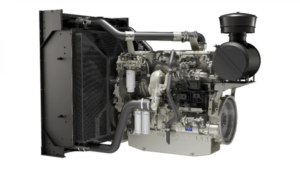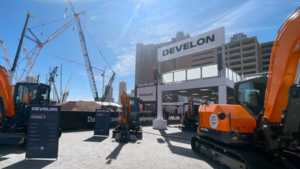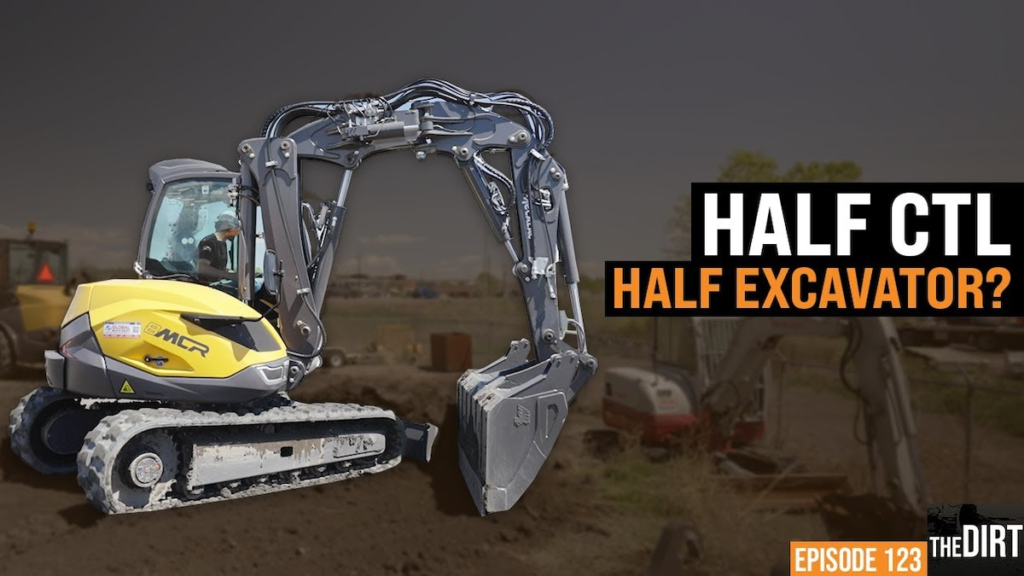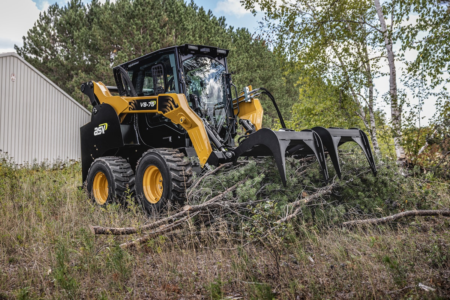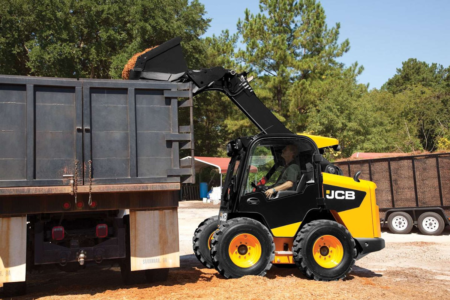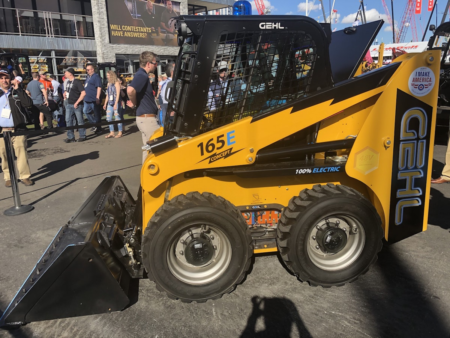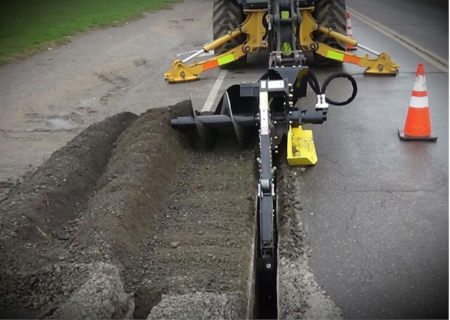Bryan Furnace (00:00):
Today we’re talking about the MECALAC 8MCR. I actually had a chance to run several machines in the MECALAC line, but the one that really stuck out to me with its potential to change the industry is the 8MCR.
If you come into the job site thinking this is going to act just like an excavator, you’re probably going to be a little disappointed simply because it’s not an excavator because guess what? This is a combination machine. This is an excavator and a skid steer in one and nine times out of 10 when you have a combination machine, that generally means it does both of its jobs, very, very mediocre and doesn’t really excel at anything. The 8MCR is the total opposite. I would say it can do 85 to 90% of everything an excavator or a skid steer can do, and then it can do a ton of extra stuff that you would never dream of doing in a skid steer or a mid-size excavator.
For instance, because of the way you can configure this boom, you can take it straight up in the air with the bucket turned around and you can have a wheelbarrow that will go two to three stories tall. Now, what’s really cool about the fact that you can use it as a skid steer is you can zip around in this machine. While it looks like a midsize excavator, it tracks along at the speed of a CTL and that’s quick. It is shockingly quick when you get in this thing for the first time.
Skid steer mode is probably the least used mode on this machine. While it’s super convenient for pick and carry operations like shuttling material across your job site and things like that, you lose a lot of your functionality because you can’t really use it as an excavator almost. You can still use it as an excavator to some degree. While you’re in skid steer mode, your controls are going to work like a skid steer. Your left hand is going to be for the movement of the machine, so forward, reverse and left to right. Your right-hand joystick is going to be boom up, boom down, and then bucket curl and uncurl. Outside of the funkiness that you’re running what appears to be an excavator, it really doesn’t take you long to mentally flip over into true skid steer mode and you just start running it like a skid steer.
(02:16):
I was shocked at how well this machine graded in skid steer mode to the point that I was very quickly able to put down a nice finished grade like I would an RTV 450 skid that we use on our job site every day. It was very intuitive to use and because of the boom configuration, the interesting thing is you get to pick which section of the boom the machine uses to raise and lower the bucket, which means for the first time you can have a radio lift and a vertical lift skid steer in one package. That’s pretty unique and it’s going to take some experimentation before I really kind of wrap my head around all the ways we could use this, but in theory you could absolutely use one boom section for your vertical lift to do all of your augering for holes or maybe you’re in a tight space and you need to go straight up against your dump truck without swinging out and away from the machine.
(03:06):
You can absolutely do that with this machine, but maybe in another scenario you’re unloading a truck and you just need that little extra bit of reach and so you use the other boom section and now all of a sudden you have a radio lift machine and you have all of the benefits that go along with that. You get to choose, we get to pick, we don’t have to stick with one right off of the dealer lot and then just be stuck with our choice for the rest of our life. We have options now and it’s awesome. So skid steer mode also gives you the ability to track like a regular skid steer, but with the use of one of your little thumb switches, it flips over a diverter valve and now your left and right movement on your movement joystick, so your left-hand joystick becomes the swing for the house. And so while using the diverter valve while we’re tracking forward at full speed, I can swing myself 90 degrees to my tracks.
(03:54):
So if we were filling alongside a pipe, guess what? I don’t have to stop. It’s not like a skid steer where we have to stop, turn, pull up to the hole and dump, back up, stop, turn, pull up to the hole and dump. No, with this machine you pull alongside your trench, you swivel over and there you go. You continue to track right along the way and as soon as you let off of your diverter valve, you are back to using your left and right for your actual turning. This is a really unique function. Let’s play out another scenario here. Let’s say we’re on asphalt or pavement. We all know that for CTLs this is a nightmare for the tracks. You’re going to chew through your tracks. It’s going to be a very high maintenance cost when using a CTL on hard surfaces. With this machine, I can go forward, I can go into my pile, I can flip my diverter valve, I can spin my machine all the way around and then I can track and reverse, which is now forward because we’re turned around.
(04:45):
I don’t have to do a three point turn to try my best to salvage my tracks as I do a 180 degree turn in my machine. Now we can just go in reverse and we’re facing forward, so it’s really easy. You can already start to see where not only is it going to save us time and efficiency, it’s also going to save us on machine wear and the cost associated with that. This is a really unique machine. Now again, skid steer mode is the most limiting mode on this machine. Great for pick and carry. Everything else, I was using excavator mode.
(05:19):
So when you’re using this machine as an excavator, one of the first things you’re going to notice is it has a mammoth bucket that is the size of a skid steer. It has the oomph and the power to actually use that bucket. I really put this thing through the test. I wanted to know if it could actually drag that monster bucket through the dirt, heap it full and then actually lift it and make it a usable bucket and this machine shock the snot out of me. Now, don’t get me wrong. When this thing is heaped and it is really loaded down and you are at full reach, absolutely you start to get tippy, you feel the weight on the machine and it does get a little questionable on whether you’re going to do that over the side of a ditch or why you’re going to swing over the side of a truck.
(05:58):
Yes, absolutely that is a lot of weight, but if you’re not at full reach, this machine comfortably handles that mammoth bucket fully heaped with no issue. As long as the material’s relatively loose, I was able to drag it through monster heaps of material with no issue. I would say this machine punches at least one weight class above where it is currently sitting in its lifting capabilities and it all has to do with that boom configuration and how you can get your lifting cylinder straight up and down when you move your boom at a certain angle and now all of that power is being applied to just lifting your load vertically, which by the way, that also translates over to craning. This thing is made to crane with anti burst valves on all of your cylinders on the boom arm stick. This thing is certified to crane.
(06:47):
It’s certified where you could put a man lift on it and believe me, with the boom configuration and how you can move this thing, you can get into some really unique scenarios with this machine and it can squeeze in there because that’s the other benefit of this machine is the tiny footprint. Now, we’re all well-versed in near zero swing machines, which is what the MECALAC 8MCR is. It’s not a true zero swing machine, but it is a minimum tail swing machine, but what we’ve always struggled with in the excavator side is what’s hanging off of the front. You still have a boom and stick that are hanging out enough to the point where you can’t swing within your track base for the most part. With the MECALAC, you can absolutely boom all the way in, use the additional boom section to boom even further in towards the machine and then rotate yourself over and have the boom positioned where the bucket is directly over the cab so you really are truly swinging in a zero radius scenario.
(07:42):
This thing is a tiny, tiny footprint. We can tuck that bucket all the way up against my blade like we would if we were in skid steer mode and it is made to do that by the way. The blade has reinforcements, the bucket has little rollers on the back of it that ride up and down on those reinforced areas on the blade. You’re not going to tear anything up by ramming piles with this machine with that bucket tucked all the way up against the blade. It’s made to do it. So that’s really cool in itself, but what’s really cool is when you put a regular digging bucket on this machine in the front shovel configuration. Because of the boom geometry, this machine actually has power to dig in a front shovel configuration.
(08:21):
We’re all familiar with the scenario where you have a pin grabber style coupler where we can rotate the bucket 180 degrees and we can start to undermine some utilities, but as we’re all familiar traditional excavators, you get to a certain point where the stick gets to interfering with the actual utilities and you can’t get any further up under there with your bucket. With the MECALAC, this isn’t an issue because we can actually use our two separate boom sections to kind of snake our stick down under the utilities and because it has actual digging power and some oomph behind it, we can full on dig under utilities with this machine. By the way, we’ve all had the other scenario where you’re trying to tie in two pieces of pipe that are coming in to intersect each other and you got to do that funky somehow tie them together and close it out and it’s really irritating. This machine can actually dig under itself because again, the boom geometry, we can suck in our second stick of boom and we can dig all the way underneath our machine.
(09:17):
This thing is so versatile. It’s unbelievable what you can do with this machine. This machine also comes with an offset boom. If you’ve never used an offset boom before, which I full disclosure, I really hadn’t messed with offset boom machines much before this review. It is unbelievable the angles you can get.
(09:34):
I would say you’re probably around 30% of what you could do with a tilt rotator. Because of the offset boom with this machine coupled with the two boom sections combined with all the other functionality you get with the excavator mode, I was able to lay down some very complex grades where we were actually coming off of a slope rotating slowly and gently into an nice flat area and you had perfect contours the entire way because this machine is able to move really in three dimensions versus a traditional excavator, you’re stuck to one or two dimensions at a time. If you were to throw a tilt rotator on this machine, this is about the only machine you would need for most of your small to mid-size landscape jobs, land clearings, this thing would do well and you can by the way get a skid plate adapter for this machine so all of your ski skid steer attachments work on it as well.
(10:26):
You’ve always thought about your skid steer attachments as skid steer attachments. Well now you have the ability to take that skid steer plate and put it on an arm that can actually move in multiple dimensions. Think about the possibilities.
(10:44):
Now, what’s really cool about the way they’ve designed this machine is you have two switches on your left-hand armrest. One is going to change your bucket controls and essentially if you think about it, when you curl the bucket in an excavator, it’s going to move one direction. If you curl the bucket in an skid steer, it’s going to go the opposite direction. MECALAC has already thought about that, so you have the option with a button on your left-hand armrest that you can switch between those two so that you don’t confuse yourself. I found myself bouncing between the two just depending on what mental mode I was in. So it wasn’t really consistent that when I was in skid steer mode, I wanted it to act like a skid steer and likewise when I was in excavator mode, I didn’t always want it to act like an excavator.
(11:25):
It really depended on the scenario and what I was doing on how I wanted the bucket to react, and it was really convenient to just have that switch that I could hit and now it’s operating as I want it to, and by the way, I should mention your primary section of boom that comes off the machine is controlled with your joysticks like a traditional excavator. It’s that second boom section that sticks out a little bit that’s going to be controlled with a foot pedal on the floor. Now, my initial knee-jerk to having a boom section being controlled by a foot pedal, I didn’t want anything to do with that. I hate the lack of control I have with my feet versus having something on my hands. I was not a fan of that idea. Now I can tell you right now, within five minutes I was pulling a perfectly flat grade using both my joysticks, using my bucket curl stick in and both boom sections and we were laid down a nice flat grade.
(12:14):
It is not nearly as daunting as you think it would be using this machine when you’re coming from a traditional excavator. Now there’s another switch that we’re going to call the stick puller or the operator switch. What it does when you flip this switch on is it takes the two boom sections and treats it as one and it makes the machine operate like a traditional excavator. Now, one of the downsides to this is because you have two cylinders operating two sections of boom, it does slow your digging down a bit. It’s noticeable, but at the same time for what you’re able to do, it’s not nearly as bad as I thought it was going to be.
(12:52):
Now I know all of you production junkies out there are going to have a giant fit saying, oh, you’ll never keep up with one of those regular eight ton machines, but you can. And I’m going to argue you’re going to out dig a traditional eight ton machine because of the fact that you can dig so tight into the machine because you can dig at all of these funky angles where we’re going to make up for that little bit of slower digging speed, we are more than going to cover in the amount of times that we don’t have to move the machine to get at the angle that we need to, to dig. It is incredible the amount of times saved by not moving. Now, there is another workaround to dig a little faster in this machine if you still want it to act kind of like a regular excavator.
(13:32):
The way I was able to do this is we will just use our standard boom back here and we will use our stick out front and we will dig within the radius that we have. And then when we’ve got that, call it maybe a third of our total length dug, then we’re going to use our foot pedal, we’re going to suck in our second boom section about halfway and then we’ll dig our next third of our trench and then we’ll suck in the boom section the rest of the way and we’ll dig the last third of our trench. Now you’re able to dig at regular speed because you aren’t using both boom sections at the same time, but you’re able to dig the entire reach of the machine with just a quick adjustment of your mid-boom section.
(14:13):
MECALAC has done a great job of making everything accessible on this machine with what they call two feet on the ground. Everything is reachable with two feet on the ground with the exception of filling the hydraulic tank, and that’s going to require you stepping up on the track. You don’t have to climb on this machine at all. Now, it is a small footprint obviously because this is the eight ton market and these are mid-size excavators. This is kind of a tiny footprint. That being said, getting to all of your valves, replacing broken lines, getting to all of your filters, everything was very easy to access from the ground and it wasn’t going to require a phenomenal amount of special tools or very tiny hands to get in there and to do the maintenance work. Everything was really accessible on this machine. Cleaning the tracks is going to be a breeze because of the track design.
(14:58):
It’s very tight area, so there’s really not a lot of mud that’s going to collect in that area. It’s going to be nice for when you’re going to trailer the machine. Now, I do have to be fair here. There are a few nitpicky things that I didn’t like about the machine that I would like to see MECALAC maybe improve upon in the future.
(16:30):
The screen is a little small from my liking, especially now that we’re getting in with some of the other modern machines that have very nice bright displays that are very easy to see in the sun. The MECALAC display is a little small, it’s a little dim, and I wasn’t a fan of some of the color choices for the icons on the screen. One of the other small irksome things about this machine is the door handle release. So when you open the door and it slaps up against the side of the machine, we’re all familiar with any other excavator. The door locks into place so that it’s not just free swinging. In order to release that on the MECALAC, you have a circle that’s about this big around on the door that is a button that you either hit with the palm of your hand or the side of your hand and it doesn’t matter which of those two you pick, it hurts. Just because of the size, the amount of pressure it takes, it does cause some discomfort on the palm of your hand or the side of your hand.
(17:21):
The last one is the fact that when you are in skid steer mode, this thing tracks like a regular CTL until you go into a turn. That’s where you are going to notice a noticeable difference in speed when you’re in the turn. Now, as soon as you stop turning, it picks right back up on the speed, so as I can imagine, most operators are going to adapt to this. We’re going to do kind of more jerky turns so that we can get through the turn and get back to speed as opposed to a regular CTL where you might just do a slow sweeping turn across the job. After spending six to eight hours in this machine, those are really the big problems that come to mind.
(17:59):
This thing is awesome. I cannot stress this enough. The way I think about the eight ton market is totally different now. If you can get this kind of versatility in the same footprint that you can get an eight ton machine into, why go with an eight ton traditional machine unless you have a very specific reason. For instance, if you’re just doing flat outright digging all the time, you don’t do any grade work, you don’t do any retaining walls, you don’t set any septic tanks, you’re just digging trenches all day long. Okay, eight ton excavator, that’s the machine for you, but most of us aren’t in that boat. Most of us need a machine that’s going to do multiple things and this machine does multiple things within the excavator realm, but on top of that, I’m going to boldly say if we were to get a MECALAC, we would probably leave our skid steer in the yard 60 to 70% of the time, and that is not an exaggeration. I can see the 8MCR totally revolutionizing the eight ton excavator market.
(18:57):
Thank you so much to MECALAC. Thank you so much to Global Machinery out there in Denver, Colorado for having us out and allowing us to try these machines out and put them through their paces. I hope this has been helpful. I hope it’s giving you something to help your business. Thank you guys so much for watching. Be sure to check out the MECALAC if you get a chance and we’ll catch you on the next episode of The Dirt.
Read the full article here


